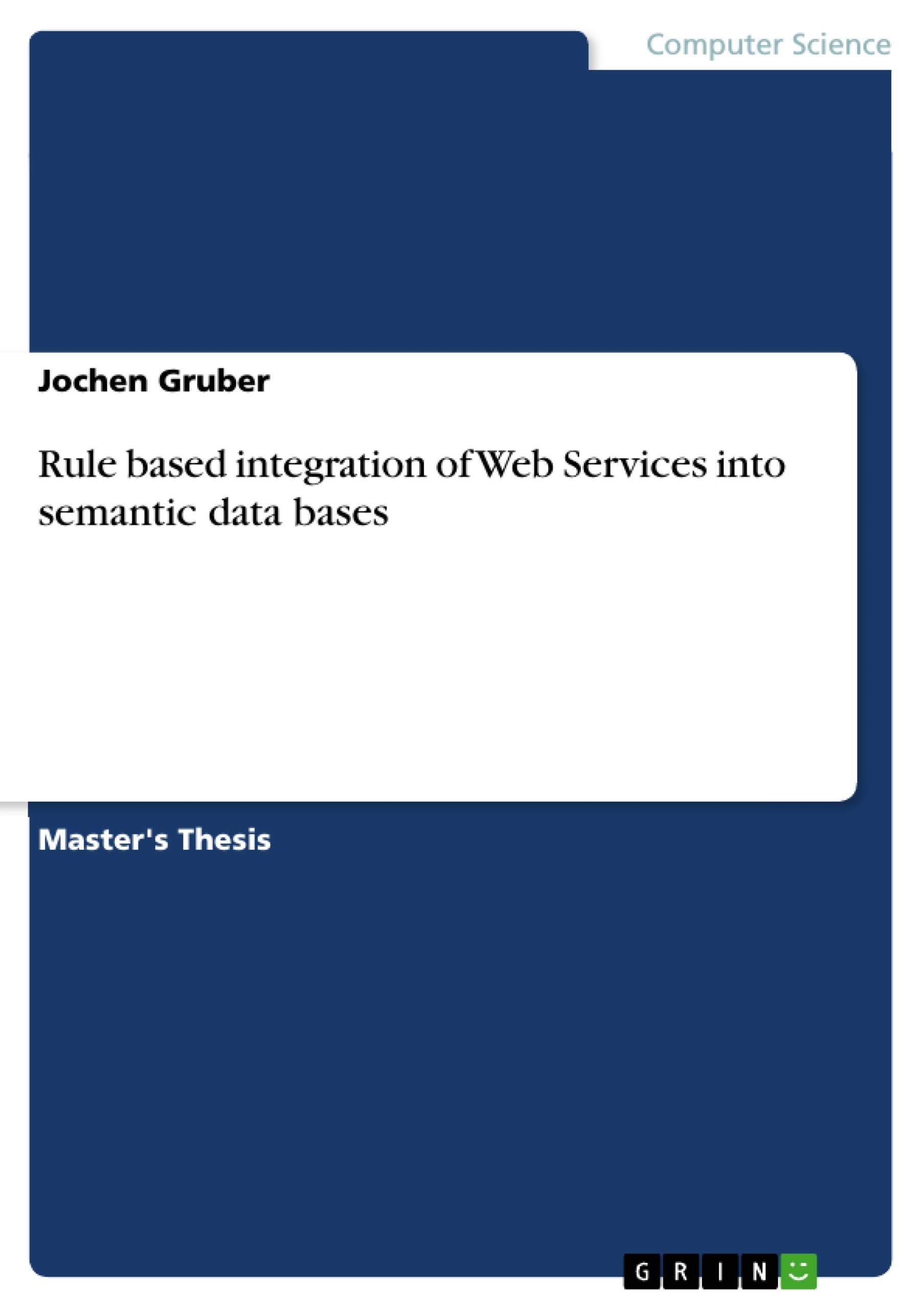Details of a semantic annotation are outlined, both for the semantic model consisting of concepts to model the area of discourse as well as the individual model for a single service. The annotation is used to build a concrete implementation of a generic processing framework translating the annotation of a service into rules to be integrated into an OWL knowledge base rule engine.
The realization is done for the Jena Semantic Web Framework, an open source library for Semantic Web application for the Java language. The realization is designed as an add-on to Jena which integrates service calls in such a way that service invocation is transparent to applications building on Jena.
A discussion on optimizations, both implemented ones and realizable but not implemented ones is included. They can serve as starting points for moving the implementation from a proof of concept status to real world usability. The section finishes with some considerations on general run-time behavior.
Finally the presented framework is evaluated in more detail: Firstly, a sophisticated scenario for the running example is described and shown, how automated service selection, composition and invocation is actually realized during run-time. Then the approach is evaluated with regard to services with more complex parameterizations with particular focus on the data supplied to the services and the rules generated from such complex parameterized services and whether such rules are still usable.
The prime design rationale of the presented framework implementation is as a proof of concept for the approach of generically integrating Web Services as rules with Semantic knowledge bases. Therefore there is still a long way to go for a real world application to be build on the framework. At several points notes are added hinting on potential challenges, particularly with regard to specific techniques for optimizing reasoning on knowledge bases. Neither are these remarks to be seen as exhaustive nor are they to be understood as short treatments. Rather they are intended as selected starting points for further research.
Inhaltsverzeichnis (Table of Contents)
- 1. Introduction
- 1.1 The Task
- 1.2 Case Studies
- 1.3 Overview
- 1.4 Notation
- 2. Current approaches
- 2.1 OWL-S
- 2.2 WSDL-S
- 2.3 WSDF
- 2.4 Remarks
- 2.5 Open questions
- 3. Semantic model
- 3.1 General modelling decisions
- 3.2 The base ontologies
- 3.3 The instance model
- 3.4 The example: Service annotations
- 3.5 The example: Process model document
- 4. Processing framework
- 4.1 Implementation rationale
- 4.2 The Jena framework
- 4.3 Implementation overview
- 4.4 Implementation details
- 4.5 Optimizations
- 4.6 Runtime behavior
- 5. Evaluation
- 5.1 Commerce use case
- 5.2 T-Info use case
- 6. Conclusion
- 6.1 Outlook
Zielsetzung und Themenschwerpunkte (Objectives and Key Themes)
The primary goal of this work is to propose an approach for automated selection, composition, and invocation of semantic web services, specifically focusing on information providing services (IPS). The approach aims to integrate IPS seamlessly with OWL knowledge bases, making service interaction transparent for both end users and applications built upon semantic web data bases.
- Integration of web services with semantic data bases
- Automated service selection and composition
- Semantic web service annotations and models
- Information providing services (IPS) and their integration
- Transparent service interaction for applications and end users
Zusammenfassung der Kapitel (Chapter Summaries)
- Chapter 1: Introduction This chapter introduces the core concept of rule-based integration of web services into semantic data bases. It outlines the three main tasks involved in software development: defining information needs, selecting and composing resources, and implementing technical details for access. The chapter highlights the significance of SOA and the need for automated web service integration, particularly emphasizing the role of semantic information in service selection and composition.
- Chapter 2: Current Approaches This chapter explores existing approaches for web service annotation and integration, including OWL-S, WSDL-S, and WSDF. It discusses the limitations of these approaches and the open questions surrounding their application in real-world scenarios.
- Chapter 3: Semantic Model This chapter delves into the proposed semantic model for integrating web services with OWL knowledge bases. It explains the general modelling decisions, the base ontologies, and the instance model. The chapter also provides an example illustrating service annotations and process model documents.
- Chapter 4: Processing Framework This chapter presents the implementation framework for the proposed approach, outlining the rationale, the use of the Jena framework, and an overview of the implementation details. It also discusses optimizations and runtime behavior.
- Chapter 5: Evaluation This chapter evaluates the proposed approach using two use cases: a commerce use case and a T-Info use case.
Schlüsselwörter (Keywords)
This work focuses on the following key concepts and topics: semantic web services, service integration, OWL knowledge bases, information providing services (IPS), automated service selection, service composition, service invocation, web service annotations, semantic modeling, and rule-based integration.
- Quote paper
- Dr. Jochen Gruber (Author), 2006, Rule based integration of Web Services into semantic data bases, Munich, GRIN Verlag, https://www.hausarbeiten.de/document/63296


